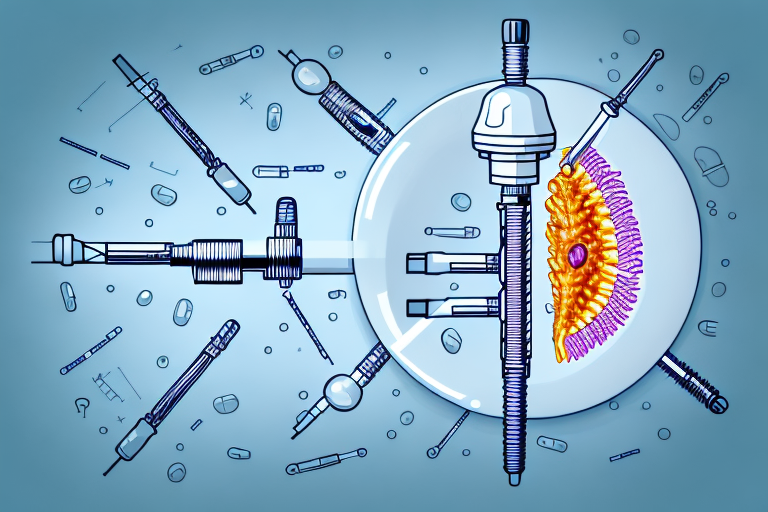Intro
Caudal steroid injections are a commonly used treatment option for individuals suffering from chronic pain in their lower back and legs. These injections, also known as epidural steroid injections, can provide significant relief and improve mobility for patients with conditions such as herniated discs or spinal stenosis. However, like any medical procedure, there are both benefits and risks that should be considered before deciding if caudal steroid injections are the right treatment option for you.
Understanding Caudal Steroid Injections
What are Caudal Steroid Injections?
Caudal steroid injections involve the injection of a corticosteroid medication into the epidural space in the lower back. This area, known as the caudal space, is located between the sacrum and the tailbone. The corticosteroid medication helps reduce inflammation and relieve pain in the surrounding nerves and tissues.
The Procedure of Caudal Steroid Injections
The procedure for caudal steroid injections is relatively straightforward and typically takes around 15 to 30 minutes to complete.
- Preparation:
The patient will be positioned on their stomach or side, and the injection site will be cleaned and sterilized. A local anesthetic may be used to numb the area before the injection is administered.
It is essential for the healthcare provider to ensure the patient’s comfort and safety throughout the procedure. The injection site is carefully prepared to minimize the risk of infection and to create an optimal environment for the injection. The healthcare provider will use sterile techniques and equipment to maintain a sterile field and minimize the risk of complications.
- Imaging Guidanc:
Using fluoroscopy or X-ray guidance, the healthcare provider will carefully insert a thin needle into the caudal space. This imaging technology allows for precise needle placement, ensuring that the medication is delivered to the intended area. The healthcare provider will monitor the needle’s progress in real-time, ensuring its proper positioning before proceeding with the injection.
- Injection
A combination of corticosteroid medication and a local anesthetic will be injected. The medication then spreads throughout the epidural space, providing pain relief and reducing inflammation in the affected area. The local anesthetic helps to provide immediate relief, while the corticosteroid medication works to reduce inflammation over time.
- Post-Procedure Care
After the injection is complete, the healthcare provider will remove the needle and apply a small bandage to the injection site. Patients may experience some mild discomfort or soreness at the injection site, but this typically resolves within a few days. It is important for patients to follow any post-injection instructions provided by their healthcare provider to ensure optimal healing and pain relief.
In conclusion, caudal steroid injections offer a targeted and effective approach to managing pain and inflammation in the lower back. By delivering corticosteroid medication directly to the affected area, these injections can provide significant relief for individuals suffering from chronic pain conditions.
The Benefits of Caudal Steroid Injections
Pain Relief and Improved Mobility
One of the primary benefits of caudal steroid injections is the significant pain relief they can provide. By reducing inflammation in the lower back and legs, these injections can alleviate chronic pain and improve overall mobility. For individuals who have been living with debilitating pain, caudal steroid injections can be a life-changing treatment option.
Imagine waking up every morning with excruciating pain in your lower back and legs. Simple tasks like getting out of bed or walking up the stairs become unbearable challenges. This constant pain affects not only your physical well-being but also your mental and emotional health. Caudal steroid injections offer hope by targeting the root cause of the pain and providing relief that allows you to regain control of your life.
With reduced inflammation, the pressure on nerves in the lower back and legs is alleviated. This means that the shooting pain, tingling, and numbness that have become a constant companion can finally be silenced. As the pain subsides, your mobility improves, allowing you to engage in activities that were once impossible. Whether it’s playing with your children, going for a hike, or simply enjoying a leisurely walk, caudal steroid injections can help you reclaim the joy of movement.
Non-Surgical Treatment Option
Caudal steroid injections offer a non-surgical alternative for individuals seeking relief from chronic lower back and leg pain. Surgery is often considered a last resort, as it carries with it the inherent risks and potential complications associated with any surgical procedure. Caudal steroid injections allow patients to explore more conservative treatment options before considering surgery.
When faced with the prospect of surgery, many individuals experience fear and anxiety. The thought of going under the knife, the recovery process, and the potential for complications can be overwhelming. Caudal steroid injections provide a less invasive option, giving patients the opportunity to try a non-surgical approach first.
Quick Recovery Time
Compared to surgical interventions, caudal steroid injections typically have a much quicker recovery time. After the procedure, patients are usually able to resume their normal activities within a short period. This means less time away from work or the activities they enjoy, allowing for a faster return to their regular routine.
Furthermore, the reduced recovery time means fewer disruptions to your life. You won’t have to put your plans on hold for an extended period, waiting for your body to heal from surgery. Instead, you can focus on enjoying life, knowing that you have taken a proactive step towards pain relief and improved mobility.
The Risks and Side Effects of Caudal Steroid Injections
Potential Complications
Although caudal steroid injections are generally considered safe, there are potential complications that should be taken into consideration.
- Bleeding
The injection site may have small blood vessels that can be inadvertently punctured during the procedure. This can lead to localized bleeding, which may require medical attention to stop the bleeding and prevent any further complications.
- Infection
Infection is another potential complication that can arise from caudal steroid injections. Although the risk is low, there is always a possibility of introducing bacteria into the injection site. To minimize this risk, healthcare providers take precautions such as sterilizing the area and using sterile equipment.
- Nerve Damage
Nerve damage is a rare but serious complication that can occur with caudal steroid injections. The injection site is in close proximity to nerves, and if the needle accidentally damages a nerve, it can result in temporary or even permanent nerve dysfunction. It is crucial to have an experienced healthcare provider perform the procedure to minimize the risk of nerve damage.
Short-Term and Long-Term Side Effects
Short-Term Side Effects
Some individuals may experience short-term side effects following caudal steroid injections.
- Temporary Numbness
Temporary numbness is a common side effect of caudal steroid injections. The local anesthetic used in the injection can cause temporary loss of sensation in the area surrounding the injection site. This numbness typically resolves on its own as the anesthetic wears off.
- Warm Sensation
Another short-term side effect that some individuals may experience is a warm sensation at the injection site. This warmth is a result of the medication spreading through the tissues and is usually not a cause for concern. It should subside within a short period of time.
- Mild Discomfort or Increased Pain
While caudal steroid injections are intended to alleviate pain, it is possible for some individuals to experience increased pain following the procedure. This can occur due to the temporary irritation of the tissues surrounding the injection site. However, this discomfort is usually temporary and should improve as the medication takes effect.
LongTerm Side Effects
The corticosteroid medication used in the injections may have long-term side effects,
- Weight Gain
Corticosteroids can affect the body’s metabolism and fluid balance, potentially leading to weight gain. It is important to discuss these potential side effects with your healthcare provider before deciding to undergo the procedure, especially if you have any pre-existing conditions that may be affected by these changes.
- Hormonal Changes
Hormonal changes can also occur as a result of corticosteroid use. These changes can affect various bodily functions and may have an impact on the endocrine system. It is essential to discuss any concerns or questions about hormonal changes with your healthcare provider to ensure you have a clear understanding of the potential risks and benefits of the procedure.
Making an Informed Decision: Is it Right for You?
Factors to Consider
Before deciding if caudal steroid injections are the right treatment for you, it is essential to consider several factors
- The severity and duration of your pain.
- Your overall health.
- Previous treatments tried.
- The potential benefits and risks associated with the procedure.
Your healthcare provider will be able to assess your individual situation and help guide you in making an informed decision.
Discussing with Your Healthcare Provider
It is crucial to have an open and honest conversation with your healthcare provider about your pain and treatment options. They will be able to provide you with detailed information about caudal steroid injections, explain the potential benefits and risks, and address any concerns or questions you may have. Together, you can decide if this treatment option is the most suitable course of action for your specific needs.
Additional Information: FAQs
- How long does the pain relief last?
The duration of pain relief varies by individual but can range from a few weeks to several months. Some patients may require repeat injections - Are there alternatives to caudal steroid injections?
Yes, alternatives include physical therapy, pain medications, nerve blocks, and, in severe cases, surgery. - How should I prepare for the procedure?
Follow your healthcare provider’s instructions, which may include fasting and temporarily discontinuing certain medications. - Who is a good candidate for this treatment?
Individuals with chronic lower back or leg pain due to conditions like herniated discs, sciatica, or spinal stenosis may benefit most. - How many injections can I receive?
The number of injections is typically limited to reduce potential side effects. Your healthcare provider will determine the appropriate frequency based on your condition. - What should I do if I experience side effects?
If you notice signs of infection, severe pain, or other unusual symptoms, contact your healthcare provider immediately for guidance.
In conclusion, caudal steroid injections can be an effective treatment option for individuals suffering from chronic lower back and leg pain. They offer significant pain relief, improved mobility, and a non-surgical alternative to more invasive procedures. However, it is vital to consider the potential risks and side effects, as well as have an open conversation with your healthcare provider to make an informed decision. If you are experiencing chronic pain, caudal steroid injections may be worth exploring as a possible solution.
Medical and Research-Based References
- Mayo Clinic – Information on epidural steroid injections and their risks/benefits. https://www.mayoclinic.org
- Johns Hopkins Medicine – Overview of spinal injections for pain management. https://www.hopkinsmedicine.org
- National Institute of Neurological Disorders and Stroke (NINDS) – Research on chronic pain management.https://www.ninds.nih.gov
- American Academy of Orthopaedic Surgeons (AAOS) – Guidelines on treating lower back pain. https://www.aaos.org
- Cleveland Clinic – Patient guide to epidural injections.
https://my.clevelandclinic.org
Disclaimer: This information is for educational purposes only and is not a substitute for professional medical advice. Always consult with a healthcare provider for a personalized treatment plan.







